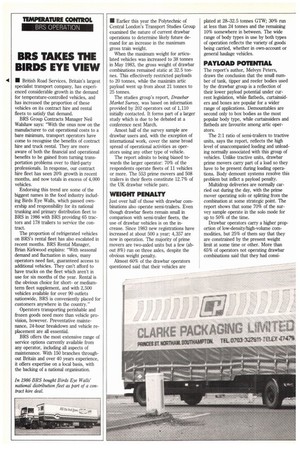BRS TAKES THE BIRDS EYE VIEW
Page 46

If you've noticed an error in this article please click here to report it so we can fix it.
• British Road Services, Britain's largest specialist transport company, has experienced considerable growth in the demand for temperature-controlled vehicles, and has increased the proportion of these vehicles on its contract hire and rental fleets to satisfy that demand.
BRS Group Contracts Manager Neil Walshaw says: "With the onus now on the manufacturer to cut operational costs to a bare minimum, transport operators have come to recognise the benefits of contract hire and truck rental. They are more aware of both the financial and operational benefits to be gained from turning transportation problems over to third-party professionals. In response, our contract hire fleet has seen 20% growth in recent months, and now totals in excess of 4,000 vehicles.
Endorsing this trend are some of the biggest names in the food industry including Birds Eye Walls, which passed ownership and responsibility for its national trunking and primary distribution fleet to BRS in 1986 with BRS providing 65 tractors and 178 trailers to service the contract.
The proportion of refrigerated vehicles on BRS's rental fleet has also escalated in recent months. BRS Rental Manager, Brian Kirkwood explains: "With seasonal demand and fluctuation in sales, many operators need fast, guaranteed access to additional vehicles. They can't afford to have trucks on the fleet which aren't in use for six months of the year. Rental is the obvious choice for shortor mediumterm fleet supplement, and with 2,500 vehicles available for over 90 outlets nationwide, BRS is conveniently placed for customers anywhere in the country."
Operators transporting perishable and frozen goods need more than vehicle provision, however. Preventative maintenance, 24-hour breakdown and vehicle replacement are all essential.
BRS offers the most extensive range of service options currently available from any operator, including all aspects of maintenance. With 150 branches throughout Britain and over 40 years experience, it offers expertise on a local basis, with the backing of a national organisation. • Earlier this year the Polytechnic of Central London's Transport Studies Group examined the nature of current drawbar operations to determine likely future demand for an increase in the maximum gross train weight.
When the maximum weight for articulated vehicles was increased to 38 tonnes in May 1983, the gross weight of drawbar combinations remained static at 32.5 tonnes. This effectiverly restricted payloads to 20 tonnes, while the rnaximim artic payload went up from about 21 tonnes to 25 tonnes.
The studies group's report, Drawbar Market Survey, was based on information provided by 202 operators out of 1,110 initially contacted. It forms part of a larger study which is due to be debated at a conference next March.
Amost half of the survey sample are drawbar users and, with the exception of international work, cover the same broad spread of operational activities as operators using any other type of vehicle.
The report admits to being biased towards the larger operator: 70% of the respondents operate fleets of 11 vehicles or more. The 553 prime movers and 508 trailers in their fleets constitute 12.7% of the UK drawbar vehicle pare.
WEIGHT PENALTY
Just over half of those with drawbar combinations also operate semi-trailers. Even though drawbar fleets remain small in comparison with semi-trailer fleets, the use of drawbar vehicles is on the increase. Since 1983 new registrations have increased at about 500 a year 4,357 are now in operation. The majority of prime movers are two-wded units but a few (about 8%) run on three axles, despite the obvious weight penalty.
Almost 60% of the drawbar operators questioned said that their vehicles are plated at 28-32.5 tonnes GTW; 30% run at less than 24 tonnes and the remaining 10% somewhere in between. The wide range of body types in use by both types of operation reflects the variety of goods being carried, whether in own-account or general haulage vehicles.
PAYLOAD POTEMI'ULL
The report's author, Melvyn Peters, draws the conclusion that the small number of tank, tipper and reefer bodies used by the drawbar group is a reflection of their lower payload potential under current legislation, while flatbeds, curtainsiders and boxes are popular for a wider range of applications. Demountables are second only to box bodies as the most popular body type, while curtainsiders and flatbeds are favourite among artic operators.
The 2:1 ratio of semi-trailers to tractive units, says the report, reflects the high level of unaccompanied loading and unloading normally associated with this group of vehicles. Unlike tractive units, drawbar prime movers carry part of a load so they have to be present during loading operations. Body demount systems resolve this problem but inflict a payload penalty.
Multidrop deliveries are normally carried out during the day, with the prime mover operating solo or splitting from the combination at some strategic point. The report shows that some 70% of the survey sample operate in the solo mode for up to 50% of the time.
Drawbar operators carry a higher proportion of low-density/high-volume commodities, but 25% of them say that they are constrained by the present weight limit at some time or other. More than 65% of operators not operating drawbar combinations said that they had consi








































































































